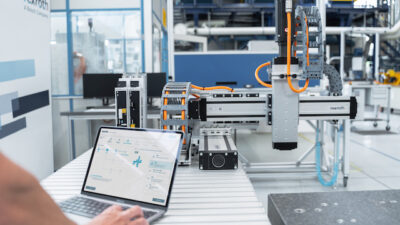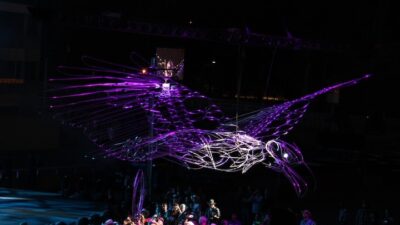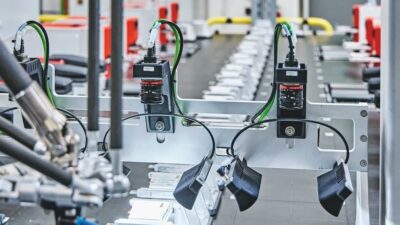Dedicated to producing the new 4.7-liter V-8 PowerTech truck engine for the 1999 Jeep Grand Cherokee, DaimlerChrysler's new Mack Avenue Engine Plant (Detroit, Mich.) has the most extensively distributed and standardized automation architecture ever applied to engine manufacture, say project participants.
|
Dedicated to producing the new 4.7-liter V-8 PowerTech truck engine for the 1999 Jeep Grand Cherokee, DaimlerChrysler’s new Mack Avenue Engine Plant (Detroit, Mich.) has the most extensively distributed and standardized automation architecture ever applied to engine manufacture, say project participants. The architecture helped cut three months off the time between plant go-ahead and commissioning, compared to conventional engine plant automation methods. It also saved $100,000 in investment costs for each of the five machining departments-blocks, heads, camshafts, crankshafts, and connecting rods.
Plant architecture is a collaborative effort between DaimlerChrysler and two Schneider Electric units, Square D and Schneider Automation. It will be refined in two plants under construction: a Detroit 3.7-liter truck engine facility and a Brazilian DaimlerChrysler/BMW joint-venture plant. As the first in a family of new DaimlerChrysler truck power plants, the 4.7-liter V-8 offers superior drivability and refinement, greater power and efficiency, fewer emissions, and less weight, compared to the V-8 it replaces, says the automaker.
Too many control schemes
In the past, an engine plant transfer line-such as a block or head machining line-usually employed one PLC per machine for 10 to 20 machines oriented in sequence. Each machine in turn might have 1 to 20 processing stations.
Even if supplied by a single vendor, the machines and stations often were of different manufacture or supplied from different vendor plants and had unique functions, control equipment, and programming. Differences between control schemes proved inefficient-transfer lines took too long to deliver, install, connect, and run and required too much operator and maintenance training.
For the new facility, DaimlerChrysler insisted vendors conform to a standard, station-level automation specification. Each station stands alone, with its own programmable logic controller (PLC), motion devices, general industrial controls, and human-machine interface (HMI) in a cabinet mounted at the station. The specification covers control component brands and models, programming standards, and networking methods between stations, machines, lines, and other equipment.
Six to eight variations of the station automation architecture accommodate various slide/wingbase arrangements. Each can be OEM developed, tested, and installed as a module. Cables to the outside world are plug-connected.
Once an operator becomes familiar with the station variations, he can understand and work on a transfer machine in any area of the plant’s Machining Department-blocks, heads, crankshafts, camshafts, whatever. The architecture in the Assembly Department, although different, is also standardized. Maintenance can walk up to any station on any machine and know that the I/O wiring, sensor numbers, etc., will be the same as any other station. The station cabinet even has a specified physical layout of PLC, motion control, and general industrial control components.
There is no overall line-controlling PLC in the new architecture. Even the machine-level PLCs, residing in the machines’ HMI consoles, are largely confined to data logging and network bridging. The plant has few offline cabinets and no mezzanines.
Hundreds of PLCs
More than 1,200 PLCs control stations, machines, transfer bars, conveyors, gantries, utility skids, departmental ‘bingoboards,’ etc. Each PLC features IEC 61131 ladder logic, and occasionally Grafcet program, with a consistent logic and register layout. Logic was prepared using a Microsoft Windows-based programming package. Because PLCs are distributed to individual pieces of equipment, control response is extremely fast, and programs are small enough to quickly troubleshoot.
The automation’s communications backbone is FIPway (WorldFIP) protocol. FIPway local area networks interconnect stations, machines, bingoboards, departments, and factory information system cell controllers (diagram).
Certain PLCs connect networks as FIPway-to-FIPway bridges or FIPway-to-Ethernet bridges. FIPway was chosen for speed, simplicity, and versatility in carrying operator interface, program load-download, interlock, and PLC-to-PLC communications traffic.
Each station has its own HMI panel or PC, depending on required capabilities. Each machine has a console PC with PLC and HMI programming software and SCADA software. Screens throughout the plant have the same look and feel, reducing the time to learn and troubleshoot equipment. A single manufacturer built most of the utility skids, incorporating the new architecture. The compatible skids were FIPway-ready as delivered and rely on the same control components, HMIs, and standards as the machine stations.
Machine interlocking is the most demanding network communications task. The Mack Avenue plant marks the first time DaimlerChrysler did not require hardwired I/O links. Instead, FIPway sharetable and common-word utilities in the PLCs pass sub-40 msec bursts of interlock data over the network. Integrity is equal to hard-wired interlocking because of built-in checks. Machine dead time at Mack Avenue has been reduced because machines cycle just hundredths of a second after the last station completes.
Gantry pick-and-place transfer systems on the crankshaft and camshaft lines make the most extensive use of network interlocking. Only a small fraction of the wires and I/O modules of past gantries had to be installed.
Cam and crank lines combine parallel-station and serial-station machines designed to meet a plant cycle time of 26 sec. One machine might have 8 stations in parallel with a 120-sec cycle time per station, while the following machine might be a serial-station design with a 24-sec cycle. The gantry part-transfer system has intelligence, memory buffer, and interlocking speed to quickly and pick up completed parts from the parallel machine’s eight stations and deliver them to the serial machine.
Most of the plant’s motion control uses electromechanical and pneumatic actuation, rather than hydraulics. To this end, 660 servo control modules-more than 1,200 axes-have been integrated into station PLC backplanes. Modules permit motion statements to be embedded in the PLC ladder logic using the PLC programming software. No separate motion package is needed. Motion profiles can be easily modified at the machine consoles. The plant also has 17 standalone CNC, averaging three axes each, for operations such as turn broaching.
For more information visit www.controleng.com/freeinfo .
| Author Information |
| Mark Fleszar is supervisor, Controls and Plant Faciliteis, Advanced Engine Manufacturing, Power Train Operations, DaimlerChrysler, Auburn Hills, Mich.Schneider Automation, North Andover, Mass., is headquarters for the worldwide automation development, manufacturing, and applications business of Schneider Electric, France. |



